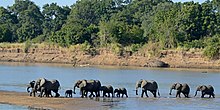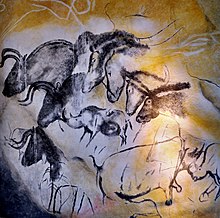herd
As a herd is known in the Zoology predominantly a collection of large, usually the same like at ground level-ongoing (kursorial) living, often exclusively herbivorous amniotes , especially large mammals and large flightless birds . The designation is independent of whether it is wild animals or domestic animals . In particular, both wild and domesticated ungulates living together in herds are referred to as herd animals .
structure
A herd is a more or less uniformly coordinated social association of fewer than ten to a few thousand individuals. Depending on its size, a herd can be an anonymous social group in which most individuals do not know each other, or an individualized social group in which the animals are familiar with each other. Under certain circumstances, especially with ruminants (Ruminantia), smaller groups, in which the group members have closer ties to one another, unite to form large anonymous herds. Such large herds can then also be composed of animals of different species, for example wildebeest , zebras and ostriches .
Smaller herds can either be organized loosely and without a (permanent) lead animal, as with male deer outside of the mating season, or hierarchically with a lead or alpha animal , as with horses . Herd behavior is dependent on many factors, be it the availability of food or species-specific reproductive behavior. A large herd with many vigilant animals reduces the likelihood of the individual animal being preyed on by a predator . Penguins stand close together in large numbers during the winter, which reduces the loss of body heat. Herd behavior is considered an evolutionary adaptation .
The herd instinct (or herd instinct ) is the observed tendency that many animal species , a coexistence in larger groups (herd, horde , pack , swarm practice), whereby the division of labor and hierarchies are visible.
Comparable names
Comparable the herd is the herd in land predators (such as the Wolf ), the school in marine mammals (such as dolphins and other whales ) and the swarm with insects , fish and birds .
In the hunter's language , herds are often given species-specific names, such as rotte in wild boars , packs in deer , jump in deer .
The more recent zoological and behavioral literature also uses Anglicisms, for example clan for family group or pack for pack.
Language history
The German word herde can be traced back to the Middle High German word hert , the Old High German herta and, via academic reconstruction , to the Germanic * herdō . Correspondences can be found in West and North Germanic languages as well as in Old Church Slavonic , which can be traced back to the pre- individual language reconstruction * kerd h ā with the meaning "row, herd, group of animals". The d in New High German probably developed under the influence of Low German .
Due to the common Indo-European origin, both the words cordd for “tribe, group, crowd” in Cymric and kórthys for “grain pile , sheaf” in Greek and their equivalents are similar . The similar-sounding word horde is not etymologically related.
Prehistory and early history
Freely arranged herds of animals are a common motif in Stone Age cave paintings . In paleontology , in addition to fossils , artistic representations of herd animals still living in the wild were used to draw conclusions about the wild fauna of that time and the tribal history of today's herd animals. Today's ideas about the way of life of the Stone Age people could also be derived from paintings with herds of animals. People living as nomads followed the seasonal migrations of the wild herds of animals. In Africa in the humid tropics , wild herds follow the rainy seasons . In the course of millennia, some herd animal species have been domesticated .
Historical time
Even in biblical times , the wealth of the rural dwellers in the regions of the earth, which at the time was shaped by early forms of civilization , consisted of the size of their herds of sheep , cattle and camels . Grazing by wild or domesticated herbivorous herd animals led to the emergence of the biotope type of open landscape in vegetation zones with forests as potential natural vegetation . Herd protection was developed to protect herd animals against wild animals or environmental influences .
Grazing by herd animals
In various forms of economy such as pasture management , alpine pasture and remote pasture management , humans make use of the herd behavior caused by the social instinct of these animals to keep the animals together in herds, to breed them and to migrate from one pasture to the next or back to the stables to steer. If the herds are too large or stay in the same pasture area for too long, there is a risk of overgrazing .
Web links
Individual evidence
- ↑ Guy Beauchamp: What is the magnitude of the group-size effect on vigilance? Behavioral Ecology. Vol. 19, No. 6, 2008, pp. 1361-1368, doi: 10.1093 / beheco / arn096
- ↑ Julia K. Parrish, Leah Edelstein-Keshet: Complexity, Pattern, and Evolutionary Trade-Offs in Animal Aggregation. Science. Vol. 284, No. 5411, 1999, pp. 99–101, doi: 10.1126 / science.284.5411.99 (alternative full text access: University of Arizona )
- ↑ Gerd Reinhold (Ed.), Soziologie-Lexikon , 2000, p. 257
- ↑ Kluge. Etymological dictionary of the German language. Edited by Elmar Seebold. 24th, revised and expanded edition. Berlin / New York 2002.
- ^ BK Pierce: The Bible Scholar's Manual Carlton & Porter, New York 1853 ( HathiTrust ), p. 173
- ^ Elinor GK Melville: A Plague of Sheep: Environmental Consequences of the Conquest of Mexico. Cambridge University Press, 1997, ISBN 0-521-57448-X , p. 164 (GoogleBooks)






